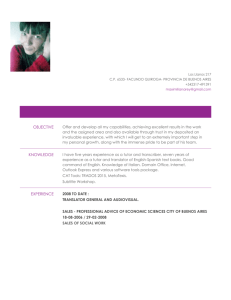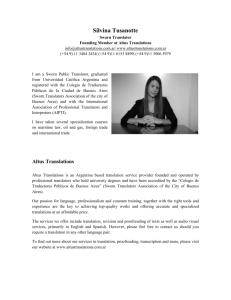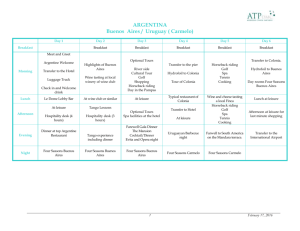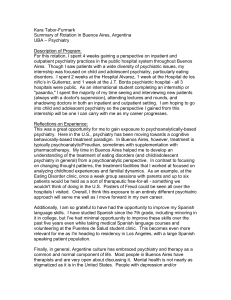X - Society for Irish Latin American Studies
advertisement
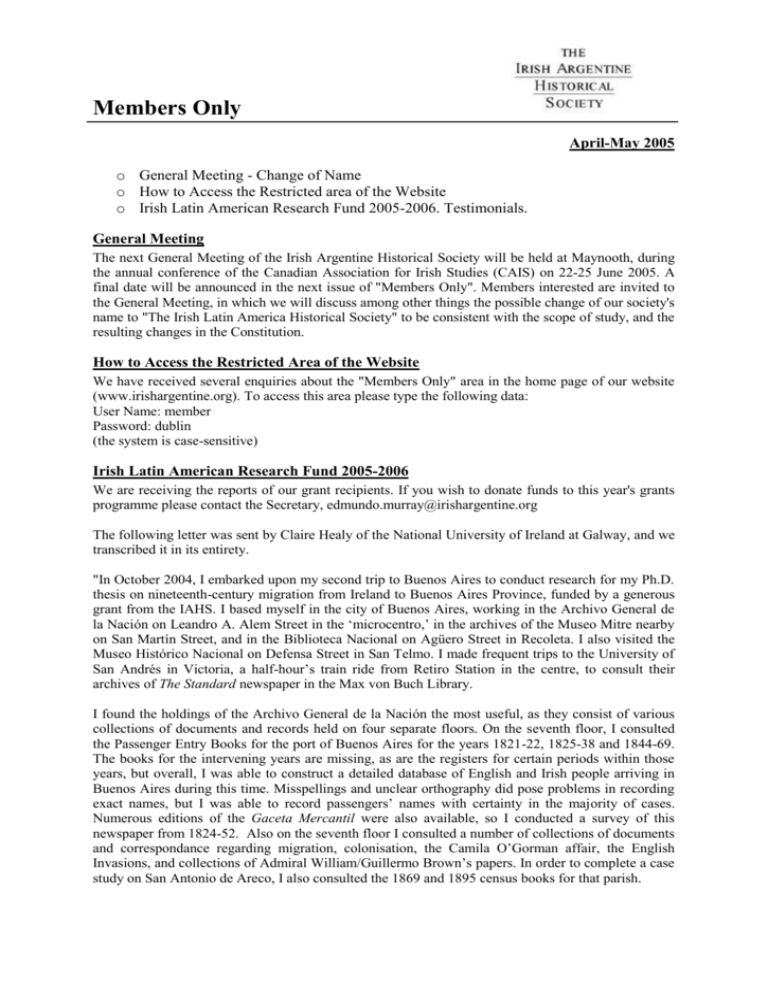
Members Only April-May 2005 o General Meeting - Change of Name o How to Access the Restricted area of the Website o Irish Latin American Research Fund 2005-2006. Testimonials. General Meeting The next General Meeting of the Irish Argentine Historical Society will be held at Maynooth, during the annual conference of the Canadian Association for Irish Studies (CAIS) on 22-25 June 2005. A final date will be announced in the next issue of "Members Only". Members interested are invited to the General Meeting, in which we will discuss among other things the possible change of our society's name to "The Irish Latin America Historical Society" to be consistent with the scope of study, and the resulting changes in the Constitution. How to Access the Restricted Area of the Website We have received several enquiries about the "Members Only" area in the home page of our website (www.irishargentine.org). To access this area please type the following data: User Name: member Password: dublin (the system is case-sensitive) Irish Latin American Research Fund 2005-2006 We are receiving the reports of our grant recipients. If you wish to donate funds to this year's grants programme please contact the Secretary, edmundo.murray@irishargentine.org The following letter was sent by Claire Healy of the National University of Ireland at Galway, and we transcribed it in its entirety. "In October 2004, I embarked upon my second trip to Buenos Aires to conduct research for my Ph.D. thesis on nineteenth-century migration from Ireland to Buenos Aires Province, funded by a generous grant from the IAHS. I based myself in the city of Buenos Aires, working in the Archivo General de la Nación on Leandro A. Alem Street in the ‘microcentro,’ in the archives of the Museo Mitre nearby on San Martín Street, and in the Biblioteca Nacional on Agüero Street in Recoleta. I also visited the Museo Histórico Nacional on Defensa Street in San Telmo. I made frequent trips to the University of San Andrés in Victoria, a half-hour’s train ride from Retiro Station in the centre, to consult their archives of The Standard newspaper in the Max von Buch Library. I found the holdings of the Archivo General de la Nación the most useful, as they consist of various collections of documents and records held on four separate floors. On the seventh floor, I consulted the Passenger Entry Books for the port of Buenos Aires for the years 1821-22, 1825-38 and 1844-69. The books for the intervening years are missing, as are the registers for certain periods within those years, but overall, I was able to construct a detailed database of English and Irish people arriving in Buenos Aires during this time. Misspellings and unclear orthography did pose problems in recording exact names, but I was able to record passengers’ names with certainty in the majority of cases. Numerous editions of the Gaceta Mercantil were also available, so I conducted a survey of this newspaper from 1824-52. Also on the seventh floor I consulted a number of collections of documents and correspondance regarding migration, colonisation, the Camila O’Gorman affair, the English Invasions, and collections of Admiral William/Guillermo Brown’s papers. In order to complete a case study on San Antonio de Areco, I also consulted the 1869 and 1895 census books for that parish. Members Only The fourth floor holds government documents from both the colonial and independent eras. There I researched aspects of the history of slavery in Buenos Aires, as well as further material on the English invasions. On the third floor I conducted thorough analyses of the 1869 and 1895 national censuses, the 1881 provincial census, the historical journal Desmemoria and some issues of Caras y Caretas. Finally, on the second floor are stored the archive’s collection of nineteenth and twentieth century daguerrotypes and photographs, which also proved useful for my research. In the Biblioteca Nacional, I consulted secondary material on immigration, colonisation, British activities in the River Plate and contemporary travellers’ accounts of the region. Books published after 1930 can be consulted on the fifth floor by visitors, but in order to access older books and newspapers, one must be accredited to the library as a researcher. The archive of the Museo Mitre is an extremely useful collection of newspapers, travellers’ accounts, and general historical works, as well as an interesting museum which conserves the furniture and personal effects of President Bartolomé Mitre. In the reading room of the museum, I studied the British Packet and Argentine News, 1828-48, some travellers’ accounts of Buenos Aires and works on the history of San Antonio de Areco. In the city I met with Andrew Graham-Yooll of the Buenos Aires Herald, Martín Casey of The Southern Cross, Eugenia Cruset, a researcher based in the University of La Plata, J.J.O’Hara of the Foxford Admiral Brown Society, Eduardo J. Clancy, a researcher and native of San Antonio de Areco, along with other researchers and members of the Irish-Argentine community. In the Max von Buch Library in San Andrés in the suburbs of Buenos Aires, I consulted microfilms of The Standard newspaper for the years 1861 to 1868. I also made repeated trips to the town of San Antonio de Areco, about 95 km from the city of Buenos Aires. There I studied in the parochial archives, which are kept in pristine condition, and comprise an entirely complete record of baptisms, marriages and funerals in the parish from 1730 to the present day, along with parish histories and other relevant documents. In San Antonio I also met with some Irish-Argentine residents, who advised me on my research, and visited the local graveyard to gain some information from the headstones. I spent a total of five months in Argentina, during which time I achieved even more than I had expected to, due to the ease with which I was able to access archives and the help which was afforded me by the various people I encountered during my stay. I will now spend the next six months writing up my thesis for submission in September. I am very pleased with the material which I acquired during my trip, and I enjoyed the experience immensely. I would therefore like to express my thanks to all of the donors to the IAHS research fund and I hope the fund continues to enable researchers to undertake such beneficial trips in the future."


